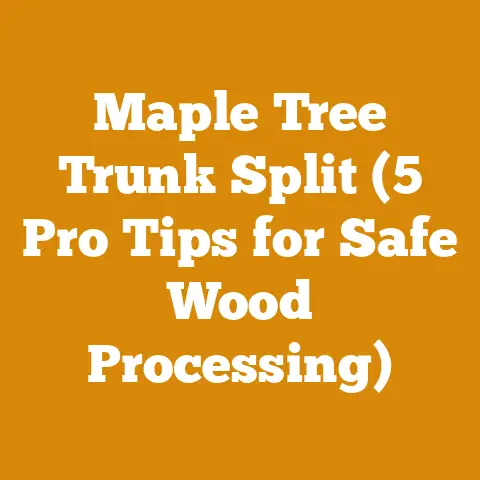How Hot Does a Wood Stove Get? (5 Expert Tips to Prevent Creosote)
Let’s dive into the heart of wood stove operation and creosote prevention! I’m going to guide you through understanding how hot your wood stove gets, why that matters, and the steps you can take to keep your chimney safe and your home warm. We’ll tackle everything from temperature ranges to burning practices, all with the goal of avoiding dangerous creosote buildup.
How Hot Does a Wood Stove Get? (5 Expert Tips to Prevent Creosote)
Understanding the temperature of your wood stove is crucial for efficient heating and, more importantly, preventing dangerous creosote buildup. Creosote is a flammable byproduct of incomplete combustion that accumulates in your chimney. Let’s break down ideal operating temperatures and how to maintain them, along with five expert tips to keep your stove running safely.
Understanding Wood Stove Temperatures
Wood stoves don’t have a single “ideal” temperature. The temperature fluctuates based on several factors, including the type of wood you’re burning, the air supply, and the design of the stove itself. However, knowing the general ranges is essential.
- Surface Temperature: This is the temperature of the stove’s exterior, usually measured with a magnetic thermometer. Optimal surface temperatures typically range from 250°F to 500°F (121°C to 260°C).
- Flue Temperature: This is the temperature of the exhaust gases inside the chimney flue. Ideal flue temperatures generally fall between 250°F and 400°F (121°C to 204°C). Maintaining this range is vital for preventing creosote.
Why Temperature Matters: The Creosote Connection
Creosote forms when unburned wood particles and gases condense in the relatively cool chimney. Think of it like condensation on a cold glass. If the flue temperature is too low (below 250°F), these byproducts condense readily, forming creosote. If the temperature is too high (above 400°F), you’re wasting fuel and potentially risking a chimney fire.
I’ve seen firsthand the devastating consequences of unchecked creosote buildup. A friend of mine, a seasoned logger, almost lost his cabin to a chimney fire caused by years of burning unseasoned wood at low temperatures. The chimney was practically choked with creosote. That experience drove home the importance of proper burning practices.
Measuring Wood Stove Temperature
There are two primary ways to measure your wood stove’s temperature:
- Surface Thermometers: These magnetic thermometers attach directly to the stove’s surface. They are inexpensive and easy to use, providing a quick indication of the stove’s heat.
- Flue Thermometers: These thermometers are installed on the stovepipe, typically 18 inches above the stove. They provide a more accurate reading of the flue gas temperature, which is crucial for creosote prevention.
I personally use both. The surface thermometer gives me a quick overview, while the flue thermometer provides more precise information about combustion efficiency and creosote risk.
5 Expert Tips to Prevent Creosote
Here are five actionable tips, backed by my experience and research, to help you maintain optimal wood stove temperatures and prevent creosote buildup:
Tip 1: Burn Seasoned Wood
This is the single most important factor in preventing creosote. Seasoned wood has a moisture content of 20% or less. Unseasoned wood can have moisture content as high as 50%, which requires a significant amount of energy to evaporate. This energy is diverted from heating your home, and the excess moisture cools the flue gases, leading to creosote formation.
How to Tell if Wood is Seasoned:
- Moisture Meter: The most accurate method is to use a moisture meter. Split a piece of wood and measure the moisture content on the freshly exposed surface.
- Visual Inspection: Seasoned wood is typically darker in color and has cracks in the end grain.
- Weight: Seasoned wood is significantly lighter than unseasoned wood.
- Sound: When struck together, seasoned wood produces a hollow sound, while unseasoned wood sounds dull.
I’ve found that oak, for example, needs at least 12 months of seasoning in my climate (Pacific Northwest), while softer woods like alder can be ready in 6-9 months. Stack your wood properly, allowing for good airflow, to speed up the drying process. I prefer stacking in single rows, slightly off the ground, with a cover on top to protect it from rain and snow.
Actionable Metric: Aim for a moisture content of 20% or less before burning. Use a moisture meter to verify.
Tip 2: Ensure Adequate Air Supply
Proper airflow is essential for complete combustion. Insufficient air leads to smoldering fires, which produce more smoke and creosote.
How to Control Airflow:
- Air Controls: Most wood stoves have primary and secondary air controls. Experiment with these to find the optimal settings for your stove and wood type.
- Damper: The damper controls the airflow through the chimney. Open the damper fully when starting a fire and adjust it as needed to maintain the desired flue temperature.
- Chimney Height: A taller chimney provides better draft, which improves airflow.
I’ve noticed that some stoves benefit from a slightly open air control even after reaching operating temperature, especially when burning dense hardwoods. Don’t choke the fire down too much, as this will inevitably lead to creosote buildup.
Actionable Tip: Observe your fire. A healthy fire should have bright flames and minimal smoke. If the fire is smoldering and producing a lot of smoke, increase the air supply.
Tip 3: Practice Top-Down Burning
Traditional fire-starting methods involve placing kindling on the bottom and larger logs on top. Top-down burning reverses this process. You place the largest logs on the bottom, followed by kindling and tinder on top.
Benefits of Top-Down Burning:
- Cleaner Burning: The fire burns downward, preheating the wood below and reducing smoke production.
- Easier to Control: The fire starts slowly and gradually increases in intensity.
- More Efficient: Top-down burning promotes more complete combustion, extracting more heat from the wood.
I switched to top-down burning a few years ago and noticed a significant reduction in smoke and creosote buildup. It takes a little practice to get the hang of it, but the results are worth the effort.
Actionable Steps:
- Place 3-4 large logs on the bottom of the firebox.
- Arrange kindling on top of the logs, crisscrossing them for good airflow.
- Place tinder (e.g., newspaper, dry leaves) on top of the kindling.
- Light the tinder and let the fire burn down.
Tip 4: Burn Hot and Fast (Within Limits)
While it’s tempting to damp down the fire to make it last longer, this can lead to creosote buildup. Burning hot and fast (within the recommended temperature range) promotes more complete combustion, reducing smoke and creosote.
How to Burn Hot and Fast:
- Use Smaller Pieces of Wood: Smaller pieces of wood ignite more quickly and burn more completely.
- Maintain Adequate Airflow: Ensure that the fire receives enough air to burn efficiently.
- Don’t Overload the Firebox: Overloading the firebox can restrict airflow and lead to smoldering.
I’ve found that burning smaller splits of wood, about 4-6 inches in diameter, allows me to maintain a higher flue temperature without overheating the stove. It requires more frequent loading, but the cleaner burn is worth it.
Actionable Tip: Monitor your flue temperature. Aim to keep it within the recommended range (250°F to 400°F) while burning.
Tip 5: Regular Chimney Inspections and Cleaning
Even with the best burning practices, some creosote will inevitably accumulate in your chimney. Regular inspections and cleaning are essential to prevent dangerous buildup and potential chimney fires.
How Often to Inspect and Clean:
- Inspections: Inspect your chimney at least twice a year, once before the heating season and once after.
- Cleaning: The National Fire Protection Association (NFPA) recommends cleaning your chimney when creosote buildup reaches 1/8 inch thick.
Methods of Chimney Cleaning:
- DIY Cleaning: You can clean your chimney yourself using a chimney brush and extension rods.
- Professional Cleaning: Hire a certified chimney sweep to clean and inspect your chimney.
I clean my chimney myself every year. It’s a dirty job, but it’s essential for safety. I also have a professional chimney sweep inspect it every few years to ensure there are no hidden problems.
Actionable Steps:
- Schedule regular chimney inspections.
- Clean your chimney when creosote buildup reaches 1/8 inch thick.
- Consider hiring a professional chimney sweep for thorough cleaning and inspection.
Choosing the Right Wood for Your Stove
The type of wood you burn also affects stove temperature and creosote production. Hardwoods like oak, maple, and ash burn hotter and longer than softwoods like pine and fir. However, softwoods can be useful for starting fires and providing quick heat.
Hardwoods vs. Softwoods:
- Hardwoods: Denser, burn longer, produce more heat, and less smoke (when seasoned).
- Softwoods: Less dense, burn faster, produce less heat, and more smoke (especially when unseasoned).
I typically burn a mix of hardwoods and softwoods. I use softwoods for kindling and starting fires, then switch to hardwoods for sustained heat.
Specific Wood Types:
- Oak: Excellent heat output, long burn time, requires long seasoning time.
- Maple: Good heat output, moderate burn time, moderate seasoning time.
- Ash: Good heat output, moderate burn time, moderate seasoning time.
- Birch: Moderate heat output, shorter burn time, faster seasoning time.
- Pine: Lower heat output, fast burn time, can produce more creosote, best for kindling.
- Fir: Lower heat output, fast burn time, can produce more creosote, best for kindling.
Actionable Tip: Choose hardwoods for sustained heat and softwoods for starting fires. Always ensure the wood is properly seasoned.
Understanding Your Stove’s Manual
Every wood stove is different. Your stove’s manual contains valuable information about its specific operating characteristics, including recommended fuel types, air control settings, and safety precautions.
Key Information in the Manual:
- Recommended Fuel Types: The manual will specify which types of wood are best suited for your stove.
- Air Control Settings: The manual will provide guidance on how to adjust the air controls for optimal performance.
- Safety Precautions: The manual will outline important safety precautions to prevent fires and other hazards.
- Maintenance Procedures: The manual will describe how to properly maintain your stove to ensure its longevity and efficiency.
I always recommend reading the manual thoroughly before operating a new wood stove. It’s the best way to understand its unique characteristics and ensure safe and efficient operation.
Actionable Tip: Read your wood stove’s manual carefully and follow the manufacturer’s recommendations.
Troubleshooting Common Issues
Even with the best practices, you may encounter issues with your wood stove. Here are some common problems and how to address them:
- Excessive Smoke: This can be caused by unseasoned wood, insufficient air supply, or a blocked chimney. Ensure your wood is properly seasoned, increase the air supply, and inspect your chimney for obstructions.
- Low Heat Output: This can be caused by burning the wrong type of wood, insufficient fuel, or a drafty room. Use hardwoods for sustained heat, load the firebox properly, and seal any drafts in the room.
- Creosote Buildup: This is a sign of incomplete combustion. Review your burning practices, ensure adequate air supply, and clean your chimney regularly.
- Backdrafting: This occurs when smoke flows back into the room instead of up the chimney. This can be caused by a blocked chimney, negative pressure in the house, or a cold chimney. Inspect your chimney for obstructions, address any negative pressure issues, and warm the chimney before starting a fire.
I once had a backdrafting issue that turned out to be caused by a clogged chimney cap. A bird had built a nest inside, blocking the flue. Removing the nest solved the problem immediately.
Actionable Tip: Troubleshoot any issues promptly. If you’re unable to resolve the problem yourself, consult a qualified wood stove technician.
Advanced Techniques for Efficient Burning
Once you’ve mastered the basics, you can explore advanced techniques to further improve your wood stove’s efficiency and reduce creosote buildup.
- Using a Catalytic Combustor: Catalytic combustors are devices that burn off smoke and gases, reducing creosote and increasing heat output. They are typically found in newer, EPA-certified stoves.
- Experimenting with Different Wood Stacking Methods: Different stacking methods can affect airflow and drying time. Experiment with different methods to find what works best for your climate and wood type.
- Monitoring Chimney Draft: Chimney draft is the force that pulls smoke and gases up the chimney. A strong draft is essential for efficient combustion. You can use a manometer to measure chimney draft.
- Using a Wood Stove Fan: Wood stove fans circulate warm air throughout the room, improving heat distribution and efficiency.
I’ve experimented with different wood stacking methods and found that single-row stacking with good airflow is the most effective for drying wood in my climate.
Actionable Tip: Explore advanced techniques to optimize your wood stove’s performance and reduce creosote buildup.
Safety First: Protecting Your Home and Family
Wood stoves can be a safe and efficient source of heat, but it’s essential to follow safety precautions to protect your home and family.
- Install Smoke Detectors and Carbon Monoxide Detectors: These devices will alert you to the presence of smoke or carbon monoxide, which can be deadly.
- Keep Flammable Materials Away from the Stove: Keep furniture, curtains, and other flammable materials at least 3 feet away from the stove.
- Use a Fireplace Screen: A fireplace screen will prevent sparks and embers from escaping the firebox.
- Never Leave a Fire Unattended: Never leave a fire unattended, especially when children or pets are present.
- Have a Fire Extinguisher Nearby: Keep a fire extinguisher readily accessible in case of a fire.
- Teach Children About Fire Safety: Teach children about the dangers of fire and how to stay safe around the stove.
I always have a fire extinguisher mounted near my wood stove and make sure everyone in my family knows how to use it.
Actionable Tip: Prioritize safety. Follow all safety precautions to protect your home and family from fire hazards.
Long-Term Maintenance and Care
Proper maintenance and care are essential for extending the life of your wood stove and ensuring its continued safe and efficient operation.
- Clean the Stove Regularly: Remove ashes and debris from the firebox regularly.
- Inspect the Stove for Damage: Inspect the stove for cracks, leaks, and other damage.
- Replace Worn Parts: Replace any worn parts, such as gaskets and firebricks, promptly.
- Lubricate Moving Parts: Lubricate any moving parts, such as door hinges and air controls, periodically.
- Protect the Stove from Rust: Protect the stove from rust by applying a high-temperature paint or sealant.
I clean my wood stove thoroughly every spring after the heating season is over. I also inspect it for any damage and replace any worn parts.
Actionable Tip: Perform regular maintenance and care to extend the life of your wood stove and ensure its continued safe and efficient operation.
The Environmental Impact of Wood Burning
While wood burning can be a sustainable source of heat, it’s important to be aware of its environmental impact.
- Air Pollution: Wood burning can contribute to air pollution, especially in areas with high concentrations of wood stoves.
- Carbon Emissions: Wood burning releases carbon dioxide into the atmosphere, which contributes to climate change.
- Deforestation: Unsustainable logging practices can lead to deforestation and habitat loss.
Ways to Reduce Environmental Impact:
- Burn Cleanly: Use seasoned wood, ensure adequate air supply, and practice top-down burning to reduce smoke and emissions.
- Use an EPA-Certified Stove: EPA-certified stoves are designed to burn more cleanly and efficiently.
- Source Wood Sustainably: Purchase wood from sustainable sources that practice responsible logging.
- Consider Alternative Heating Options: Explore alternative heating options, such as solar or geothermal, to reduce your reliance on wood burning.
I source my wood from local suppliers who practice sustainable logging. I also use an EPA-certified stove and burn cleanly to minimize my environmental impact.
Actionable Tip: Be mindful of the environmental impact of wood burning and take steps to reduce your footprint.
Final Thoughts
Understanding how hot your wood stove gets and implementing these five expert tips is crucial for safe and efficient heating. By burning seasoned wood, ensuring adequate air supply, practicing top-down burning, burning hot and fast (within limits), and performing regular chimney inspections and cleaning, you can prevent dangerous creosote buildup and enjoy the warmth and comfort of your wood stove for years to come. Stay warm, stay safe, and burn smart!
My journey with wood stoves has been a continuous learning experience. From the initial struggles with unseasoned wood to the satisfaction of a perfectly burning fire, I’ve gained a deep appreciation for this traditional heating method. I hope this guide has provided you with the knowledge and tools you need to navigate the world of wood stoves with confidence and safety.






